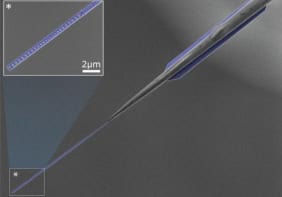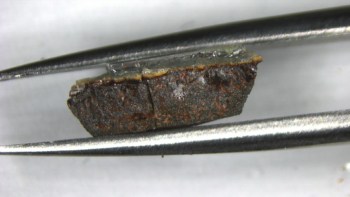
While humans have been writing for at least 5000 years, we have surprisingly little understanding of the physics underlying how ink moves from pen to paper. Now, physicists in South Korea and the US have worked out a theory – backed by experiment – that suggests the ink’s flow rate depends on a tug-of-war that is played out between the capillary properties of pen and paper.
The team, led by Ho-Young Kim of Seoul National University, considered two scenarios: the blot and the line. With the pen stationary, the researchers identify four main factors that affect the flow of ink: the capillary pull of the pen; the capillary pull of the pores in the paper; the surface tension of the ink; and the viscosity of the ink. When it is moving, the speed of the pen is a fifth factor.
The team’s theory defines a “minimal pen” as a simple capillary tube, not unlike the hollow reeds used by the Egyptians to make inscriptions on papyrus. The researchers approximate paper as an array of cylinders. Rough paper is modelled as narrow, closely packed pillars, while shorter, wider, more generously spaced pillars are used to approximate smoother paper. While paper is actually a much more complex matrix of cellulose fibres, the team argues that such arrays draw fluid through the same mechanisms that allow paper to draw ink from a pen.
Pulling power
The smaller cavities in paper have a greater capillary pull than the wider tube of the pen, but very small pores also restrict the flow of the ink. As long as the pores in the material are not wider than the opening in the minimal pen, rougher materials pull ink more quickly. This also explains why it is so difficult to write in pen on a piece of glass – without pores, the surface cannot draw ink. In contrast, wider pens have less capillary force, so they give up the ink more easily. As for the ink itself, higher surface tension allows it to wet the paper or pillar array more effectively, while higher viscosity slows it down. The team condensed these relationships, plus the time that the pen spends in contact with the paper, into scaling laws.
Kim’s group confirmed the models by making the idealized pen and paper in the lab. The researchers etched silicon wafers into patterns of pillars 10–20 µm in diameter, height and spacing. Glass capillary tubes with diameters of 0.5–1 mm served as pens, filled with various concentrations of glycerine solution for mock ink. The team filmed the spread of ink blots and the drawing of lines, finding that the data matched their models.
After millennia of writing, you might think there would be nothing unexpected in these results, but Kim says that the shape of the ink in front of the moving pen was a surprise. “We showed that the actual shape is exactly parabolic – beautifully simple but nobody has predicted it,” he explains. The reason for the parabola is that the pores in front of the moving pen draw the bulk of the ink, while the pores behind are already at full capacity.
Putting pen to paper
Testing their scaling laws with a real pen and paper, the researchers held a 0.1 mm-diameter nib against ordinary paper for 2 s. They predicted a blot radius of 3 mm, expecting a line width of 0.82 mm with the pen moving at 5 mm s–1. The actual line width was quite close, 0.7 mm, while the blot was not quite half the predicted size at 1.3 mm. The team explains the difference in terms of paper swelling. Unlike rigid silicon, cellulose fibres deform as they imbibe fluid, thereby increasing the size of the pores.
Laurent Courbin of the University of Rennes, France, describes the study as fun that strikes at the heart of physics. “The aim of a physicist is to identify interesting problems not yet understood and to make such problems understandable using the simplest possible theoretical models,” he says. “When such investigations involve physical phenomena we experience in our everyday life, our work is even more rewarding!”
Although the team did not directly simulate the need for pocket protectors, Kim says that “ink stains on shirts from a pen in the pocket are very good examples of the ink blot that we treated”. At last, the pragmatic have a rigorous proof for why the nerdy plastic lining is a good idea.
This research will be published in Physical Review Letters.



